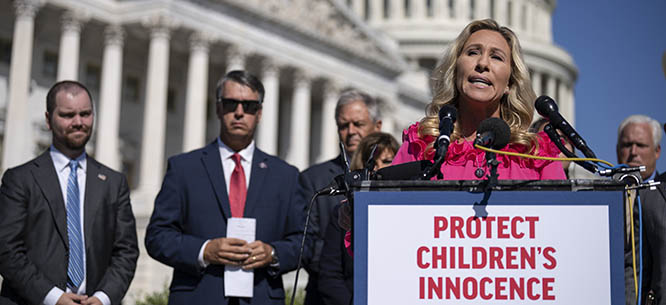The Bad Science Behind Trans Medicine Bans
The Bad Science Behind Trans Medicine Bans
The conservative movement has built its case against gender-affirming care on the authority of anachronistic, faulty clinical research.

In United States v. Skrmetti, the Supreme Court’s conservative justices are poised to uphold bans on medicine for transgender minors. According to Tennessee Attorney General Jonathan Skrmetti, who is defending his state’s ban, trans youth are not a vulnerable minority deserving of civil rights protections. Rather, they are the victims of dangerously uncertain medical practices.
Tennessee, along with twenty-five other states, allege that a rapid increase in diagnoses of gender dysphoria is pushing the nation’s children toward “experimental,” “unproven,” and “excessively risky” gender transition care, ranging from puberty-suppressing medications to surgical procedures. The court’s decision, expected in June, is likely to affirm state lawmakers’ wide latitude to regulate matters of “medical and scientific uncertainty,” a principle that the court’s right-wing bloc previously articulated in a case featuring erroneous claims about certain abortion procedures’ potential health risks. If the court is similarly convinced by this caricature of gender-affirming care, it is likely to uphold these bans as a constitutionally appropriate exercise of a state’s power over public health and safety despite their clear violation of the Constitution’s equal protection clause.
Skrmetti’s argument is bolstered by a broader conservative panic over trans medicine. According to the most paranoid versions of the argument, the vast majority of trans youth are not who they claim to be. Instead, they have been corrupted by social media algorithms and the allure of modern medicine—that is, Big Tech and Big Pharma—and the sinister, or unwitting, clinicians who treat kids’ depression and anxiety with hormones and pronouns. Summing up this sentiment, the Manhattan Institute’s Christopher Rufo has called for lawmakers to ban “gender pseudoscience” and to “put the transgender empire out of business forever.”
These arguments have been rightly challenged by progressives for their lack of scientific basis. After all, the medical establishment is today broadly supportive of trans medicine, including for minors. The American Medical Association and American Academy of Pediatrics have described gender-affirming care for youth as safe, efficacious, and “medically necessary.” But for those of us who wish to challenge trans medicine bans, it is important to recognize how anti-trans arguments use scientific research to bolster their claims. Conservative talk of social contagions, uncertain clinicians, and an increase in pharmaceutical-forward interventions in fact does have a foundation in the medical record, just one that has been wildly distorted.
The scientific arguments that pepper lawmakers’ justifications for banning gender-affirming care draw on a previous generation of clinical research that reflects its anachronistic beliefs, biases, and often faulty methodologies. But this older research has been adroitly put to use by a cohort of contemporary skeptics within and outside of the mental health profession. It is upon the authority of those displaced experts—some of whom still vie for relevance against a newer, more affirmative model of care—that the conservative movement has built its case against trans medicine.
The first gender identity clinics in the United States were concerned less with changing sex than they were with saving it. In the decades before these clinics opened their doors in the 1960s, transsexual adults (the clinics’ preferred nomenclature) had become a media and medical obsession, in large part due to developments in surgical procedures and the invention of synthetic hormones. Although the medical establishment mostly opposed transition care—their techniques were mainly reserved for coercive treatments of intersexed patients—surgeons and endocrinologists routinely heard pleas for intervention from those who had felt their gender nonconformity deeply since childhood.
Perversely, these encounters convinced psychiatrists and psychologists that if they better understood the nature of child gender nonconformity, they might be able to nip it in the bud before it blossomed into a social problem. They were especially concerned with the gendered fates of those they deemed feminine, or “sissy,” prepubescent boys. Two of the most prominent researchers, psychologist John Money and psychiatrist Richard Green, the latter of whom drafted the original 1980 diagnostic criteria for what was called Gender Identity Disorder of Childhood (GIDC), repeatedly found that feminine “boys” typically grew up to be gay male-identified adults rather than trans women, signaling that trans-identification was a rarity even among this population. Gender identity disorder was thought to be even rarer for their assigned-female counterparts, who were excluded from most research.
No matter the sex of the child, the clinical goal was to correct, not affirm, their gender nonconformity. The medical recommendations that followed from these early clinical observations prescribed behavioral modification treatments that coaxed young patients into abandoning their cross-gendered identifications. Patients were encouraged to “work through” the underlying causes of their dysphoria or learn to reduce their gender-variant behaviors and increase their identification with their assigned sex. Treatments involved restricting an assigned-male patient’s access to “girly” toys, clothing, and hobbies, while promoting athletics and time spent with their fathers and male peers.
Despite their aims, Green and his colleagues often struggled to change their patients’ behaviors and desires. In the face of such failures, some early gender clinics began offering transition options once puberty had set in, at which point a child’s gender was thought to have ossified. After the window of opportunity to curb nonconformity had closed, there was sometimes little left to do but admit defeat in the face of a patient’s stubborn sense of self.
Recently, this style of clinical care has given way to a more affirmative model, one that does not prioritize any predetermined sexual or gendered outcome. Clinicians are often now encouraged to “follow the child’s lead.” For some, this entails a social transition in which an assigned-male child might be allowed to wear dresses to school and given space to talk with a mental health professional about their feelings and experiences. For others on the cusp of adolescence, it can include prescribing puberty-suppressing medications that allow a child time to decide their gendered future without the pressures of imminent physical changes.
Between the era of Green’s dominance and its recent eclipse by the modern affirmative model, a generation of clinicians expanded youth access to transition care while retaining some of the harmful features of the original clinics. Psychologist Kenneth Zucker is a prominent member of the generation who was inspired by Green’s work; now, his research and professional commentaries dot the legal briefs advocating for trans medicine bans. Zucker has been keenly interested in differentiating between those children who will desist in their gender dysphoria and those who will persist. Though he does not oppose medical intervention—at one point, Zucker reportedly referred more gender dysphoric youth for puberty-suppressing treatments than any other clinician in North America—he has urged patients to accept their assigned sex if at all possible, a practice that some have criticized as conversion therapy. Zucker’s scholarly writings defend this “live in your own skin” approach, which regards young people’s gender dysphoria as likely to dissipate with time and treatment.
In 2018, this idea of gender dysphoria as a temporary phase was given new life with the publication of an infamous—and largely discredited—study on “rapid onset gender dysphoria,” or ROGD. Although the term has a jargony clinical resonance, it was coined by a physician-researcher, Lisa Littman, who has no expertise in trans healthcare and whose data drew primarily from the parents of trans children who had gathered on “gender critical” online forums. The ROGD study claims that growing numbers of assigned-female adolescents have suddenly become gender dysphoric during or after puberty without any of the traditional signs of dysphoria earlier in childhood that Green and others had identified. The term quickly became a staple of anti–trans medicine politics, especially because the study pointed toward the influence of social media, a new bogeyman of the right. According to the ROGD narrative, vulnerable young girls are led by peers precipitously toward unwarranted medical transition when all they really need are sympathetic therapists and time away from their phones.
The apparent novelty of the ROGD population quickly caught the eye of prominent clinicians and researchers. Zucker has entertained ROGD as a possible new “developmental pathway.” According to earlier studies and clinical observations, “persisters” typically express their gender dysphoria in two ways. Some show signs very early, even before preschool age, and this version can present in either assigned-males or assigned-females. Other persisters experience “late-onset” gender dysphoria well after they have undergone puberty, and these patients tend to skew assigned-male. The ROGD population, however, is presumably composed mainly of assigned-female adolescents who had—at least according to their parents—never previously experienced gender dysphoria. This group is new to researchers, and for Zucker, the fact that clinicians have no clue whether individuals will persist or desist has rung alarm bells. If the expert’s role is to facilitate transition only as a last resort, perhaps hormone replacement therapies should yield to a strict regimen of talk therapy, lest these teenagers choose the wrong gender identity.
The problems with experts like Zucker’s flirtations with ROGD and the enduring obsession with ancient desistance statistics are myriad. Contrary to the numbers proffered by some pediatric gender identity clinics, research has shown a higher rate of gender dysphoria among adolescents assigned-male than those assigned-female. Moreover, ban proponents’ favorite review study on desistance rates among pediatric patients includes mostly research from the 1960s, 1970s, and 1980s that featured only assigned-male patients. This historic exclusion of assigned-female patients likely makes contemporary gender dysphoria demographics appear far more novel than they are. Furthermore, a recent study of trans and gender-nonconforming adults demonstrated that many adolescents wait years to come out after their first realizations of their gender identities, indicating that the ROGD population is possibly not so unprecedented. What is new might simply be adolescents’ increased access to affirmative care and a relatively tolerant social milieu.
Second, and contrary to conservative media campaigns about the horrors of detransition, those who do cease taking hormones or otherwise return to their assigned gender typically do so due to social stigma, trouble gaining or maintaining employment, or another adverse social reason rather than because a clinician “got it wrong.” A recent study that focused on youth who were prescribed either puberty-suppressing or hormone replacement medications found that 97 percent continued to access gender-affirming care several years after first beginning treatment. Another study observed a staggering 94 percent persistence rate in trans identification five years after an initial social transition. Detransition, while real, appears to be exceedingly rare and not at all synonymous with regret.
Lastly, undergirding these speculations on demographic shifts and fears of regret is a persistent belief that there are those individuals who are truly trans—in a deep, biologically determined way—and those who are following a trend. But that perspective is skewed by bad data and an inherently conservative disposition toward changing gender norms, which animates Tennessee’s concern over an “explosion” of gender dysphoria diagnoses. It assumes that gender-nonconforming teenagers in 2024 should match a snapshot image of their counterparts a generation or two earlier when studies of trans people were unrefined and gender nonconformity was much more socially maligned. After all, it is possible that the tide of tolerance has allowed more people to express themselves. In the view of both ROGD and classical takes on desistance, however, there is an implicit binary, and a coercive one at that. You are either trans or not, and the experts will make that decision for you.
Beyond concerns over who belongs in the trans population, some gender identity clinicians have taken a more total stance against pharmaceutical interventions for minors. These clinicians suggest that psychotherapy should almost always preempt other methods, even nonmedical ones like social transition.
The most influential proponent of this therapy-first approach is psychiatrist Stephen B. Levine, a former leader in trans medicine who served as an expert witness for Tennessee in litigation over its ban on gender-affirming care. Levine was an institution builder: in 1974, he founded a gender identity clinic at Case Western Reserve University, and he later served on an American Psychiatric Association committee that shifted the profession’s diagnostic manual further away from the stigma-laden term “transsexualism.” Still, Levine viewed gender dysphoria as most often an expression of underlying psychological problems, a condition that demanded a comprehensive psychiatric evaluation and psychotherapy as a first-line intervention. Rather than affirm a patient’s self-identification as trans, Levine insisted that professionals probe the psyche, looking for evidence of narcissism or some other pathology that may have diverted a person’s attention away from a deeper psychic pain and toward their gender identity.
By the late 1990s, Levine and others in the old guard faced mounting criticisms from trans people who—much like the gay and lesbian activists who once protested psychiatry’s pathological rendering of homosexuality—demanded a seat at the table. Levine’s time as a leader in the Harry Benjamin International Gender Dysphoria Association (HBIGDA)—the first major medical association of its kind—was marked by this contestation. As trans advocates gradually made inroads into the HBIGDA, the association shifted some authority away from the mental health professions, eventually trading the name for a new one, the World Professional Association for Transgender Health (WPATH). Rightly perceiving an eclipse of his authority, Levine exited the association.
Levine’s position on gender-affirming care has remained largely consistent ever since. For his younger patients, Levine has opposed the use of puberty-suppressing medications and has entertained ROGD’s insights, reasoning that gender-dysphoric adolescents may simply be responding to “ordinary developmental angst” made worse by access to the internet. Perhaps unsurprisingly, Levine shares the view that most of these youth will quickly desist.
Although Levine’s clinical perspective has been relegated to the margins of trans medicine, it has recently gained traction with fringe medical associations and discontented mental health professionals. These professionals—particularly pharma-skeptic psychoanalysts—view the increasing acceptance of gender-affirming medical interventions as not just a threat to traditional gendered ideals, but also a threat to their professional dominance. One such group called Genspect counts Levine and Littman among its advisors. Another advisor, the Jungian psychoanalyst Lisa Marchiano, actively assisted Littman in drafting her original article on ROGD. Among those listed on Genspect’s curated directory of therapists is Susan Evans, a psychoanalyst who was previously employed by the National Health Service’s Gender Identity Development Service (GIDS) clinic as a nurse before she quit over the clinic’s “precipitous referral” of youth for medical transition. More recently, Evans spearheaded a consequential lawsuit against the UK clinic’s use of puberty-suppressing medications.
On its blog, Genspect has promoted conspiratorial views on gender-affirming care, including those that blame Big Pharma for its deceitful promise that profitable medical salves can treat the wounded psyches and souls of dysphoric patients-cum-customers. Such criticisms of the pharmaceutical industry’s undeniable role in shaping our collective notions of health and identity might be more convincing if they were not so trans exceptionalist. Modern medicine is rife with gender-affirming procedures like post-menopausal hormone replacement, testosterone supplements for aging cis men and gym rats, and a host of surgical operations including breast augmentations, nose jobs, and jawline-enhancing chin implants. But none of those procedures receive nearly the same scrutiny that trans medicine incurs.
Such accusations of drug company corruption also buttress the legal argument that puberty-suppressing medications are so uncertain that the Food and Drug Administration has not even approved their use in gender dysphoric adolescents. There is some truth here mixed in with abundant obfuscation. The FDA has only officially approved these drugs for those experiencing precocious puberty and, accordingly, their use in trans patients is considered “off-label.” That might be a scandal if off-label prescriptions were not extraordinarily common in children, partially because pediatric clinical trials are often not cost effective for drug companies to undertake (which is an actual scandal). And unlike many other drugs that have only been approved for adult patients, puberty-suppressing drugs have been tested in a pediatric population, just not gender-dysphoric kids specifically.
In place of gender-affirming care, Genspect leaders have encouraged the use of “gender exploratory” therapy, which they speciously describe as an “agenda-free” and “neutral” alternative. While gender-exploratory therapy’s advocates are technically correct when they assert that all mainstream therapies involve some element of exploration, this practice withholds medical transition and even discourages social transition rather than following the lead of the child’s own open-ended exploration. Last year, a batch of leaked emails revealed that Genspect’s leadership would never recommend transition for anyone, including adults. A month prior to that leak, Genspect members established the Killarney Group, a think tank that aims to produce an authoritative “non-medical guide” rivaling WPATH’s internationally renowned standards for gender-affirming care.
Other groups like the Gender Exploratory Therapy Association (GETA)—which shares a significant number of Genspect members and now goes by the name Therapy First—have offered an untested therapeutic approach that aims to look beneath the surface of an individual’s gender dysphoria. Inspired by Levine’s work—in fact, he coauthored GETA’s guide to exploratory therapy—these “truer” roots might include unprocessed trauma or childhood abuse, self-hatred, fetishism, or even autism.
Buried in the scaremongering about accelerated transitions, there is a political-economic dimension to the calls for more talk therapy. Writing in the Washington Post in 2021, Laura Edwards-Leeper, who cofounded the first U.S.-based interdisciplinary pediatric gender identity clinic, and former WPATH board member Erica Anderson claimed that teenagers might receive less therapeutic care not because of Big Pharma’s hormone peddling, but rather because gender clinics have become “disastrously overwhelmed.” The two are not entirely unrelated given the omnipresence of psychiatric drug prescriptions in the United States and the paucity of high-quality, affordable talk therapy for everyone, not just those experiencing gender dysphoria. But gender identity clinics do seem to be suffering disproportionately.
Similarly in the UK, clinical psychologists have lamented that the role of austerity has been overlooked in debates over trans medicine. There, longstanding cuts to the National Health Service have reduced the local availability of psychotherapeutic resources for gender-dysphoric youth. For several years, these transformations to the health service left the system’s singular gender identity clinic for children and youth, GIDS, with responsibility for a swelling case load. In 2024, GIDS collapsed, buckling under the weight of both its conservative critics and the protests of those parents and patients who could not bear wait times that extended beyond eighteen months and the slow processes they encountered inside the clinic’s doors.
This is all a shame not least because today’s dysphoric adolescents and children might want or benefit from more gender-affirming talk therapy. The best of affirmative therapy supports trans youth who invariably face discrimination and invalidation as they navigate their unfolding self-understanding. That is, of course, something that the exploratory model fails to do in its inherent skepticism and its relentless efforts to expose the supposed ugly truth beneath gender’s surface.
Unfortunately, the Supreme Court’s conservative majority will likely not reckon with these resource constraints on trans healthcare when it decides Tennessee’s case. And to the extent that the court bothers to examine trans medicine’s historical development and its ongoing paradigm shift toward an affirmative model, it will do so on the absurd grounds that the science of gender-affirming care is so uncertain as to merit legal prohibition.
Tennessee has made great use of the gender identity clinical record’s vestiges in advancing just this claim. The state’s brief is replete with references to a changing patient population, an insistence that desistance is the norm, and a chivalrous cry to prevent the “tragic ‘regret’ of detransitioners.” In an amicus brief supporting Tennessee, Genspect has buttressed these arguments, citing Levine and Green as authorities. The fact that Levine is now such an outlier among his professional peers seems to pose little problem for trans medicine’s critics, armed as they are with an outdated set of studies and expert pronouncements.
If Tennessee and Genspect have their way, the court’s decision will be an immediate injustice for every trans child in those twenty-six states that have banned care. It will also be an epistemic injustice with profound political consequences that will resound across other ongoing, vulgarized conflicts over the nature of expertise and certainty in public health and reproductive rights, leaving us with fewer ways to defend against former generations’ science and the ideologies with which it has been suffused.
Joanna Wuest is an assistant professor of women’s, gender, and sexuality studies at Stony Brook University and a public fellow in LGBTQ Rights at the Public Religion Research Institute (PRRI).
Briana S. Last is an assistant professor in the department of psychology at Stony Brook University.






